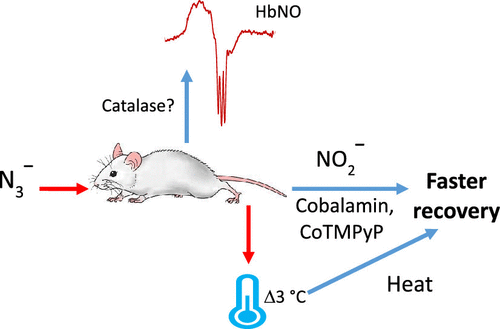当前位置:
X-MOL 学术
›
Chem. Res. Toxicol.
›
论文详情
Our official English website, www.x-mol.net, welcomes your
feedback! (Note: you will need to create a separate account there.)
A Comparison of Potential Azide Antidotes in a Mouse Model.
Chemical Research in Toxicology ( IF 3.7 ) Pub Date : 2020-01-23 , DOI: 10.1021/acs.chemrestox.9b00422 Kristin L Frawley 1 , Samantha Carpenter Totoni 1 , Yookyung Bae 1 , Linda L Pearce 1 , Jim Peterson 1
Chemical Research in Toxicology ( IF 3.7 ) Pub Date : 2020-01-23 , DOI: 10.1021/acs.chemrestox.9b00422 Kristin L Frawley 1 , Samantha Carpenter Totoni 1 , Yookyung Bae 1 , Linda L Pearce 1 , Jim Peterson 1
Affiliation

|
Three cobalt-containing macrocyclic compounds previously shown to antagonize cyanide toxicity have been comparatively evaluated for the amelioration of sublethal azide toxicity in juvenile (7-8 weeks) Swiss-Webster mice. The lowest effective doses were determined for hydroxocobalamin, a cobalt porphyrin, and a cobalt-Schiff base macrocycle by giving the antidotes 5 min prior to the toxicant, 27 mg (415 μmol) /kg sodium azide. Both male and female mice were evaluated for their response to the toxicant as well as the antidotes, and no significant differences were noted once weight differences were taken into account. Two of the three compounds significantly decreased the recovery time of azide-intoxicated mice at 10 min after the administration of sodium azide, as determined by a behavioral test (pole climbing). Additionally, azide was determined to cause a several degree drop (∼3 °C) in measured tail temperature, and warming the mice led to a more rapid recovery. The mice were also shown to recover more rapidly when given sodium nitrite, 24 mg (350 μmol)/kg, 5 min after the toxicant; this treatment also suppressed the azide-induced tail temperature decrease. Electron paramagnetic resonance (EPR) measurements of mouse blood treated with sodium azide demonstrated the presence of nitrosylhemoglobin at levels of 10-20 μM which persisted for ∼300 min. The presence of the methemoglobin azide adduct was also detected by EPR at a maximum level of ∼300 μM, but these signals disappeared around 200 min after the administration of azide. The treatment of mice with 15N sodium azide proved that the nitrosylhemoglobin was a product of the administered azide by the appearance of a two-line hyperfine (due to the 15N) in the EPR spectrum of mouse blood.
中文翻译:

小鼠模型中潜在叠氮化物解毒剂的比较。
已对三种先前显示可拮抗氰化物毒性的含钴大环化合物进行了评估,以改善其在7至8周的Swiss-Webster小鼠中的亚致命叠氮化物毒性。通过在解毒剂前5分钟给予解毒剂27 mg(415μmol)/ kg叠氮化钠,确定羟考巴兰,钴卟啉和席夫碱钴大环化合物的最低有效剂量。评估了雄性和雌性小鼠对毒物和解毒剂的反应,并且考虑到体重差异后,没有发现明显差异。通过行为测试(极点攀爬)确定,三种化合物中的两种在施用叠氮化钠后10分钟时显着降低了叠氮化物中毒小鼠的恢复时间。另外,确定叠氮化物会导致所测量的尾巴温度下降几度(〜3°C),并且加热小鼠会导致更快的恢复。还显示,在毒性试验后5分钟,给予亚硝酸钠24 mg(350μmol)/ kg时,小鼠恢复得更快。这种处理也抑制了叠氮化物引起的尾部温度降低。用叠氮化钠处理的小鼠血液的电子顺磁共振(EPR)测量结果表明,亚硝酰血红蛋白的含量为10-20μM,持续约300分钟。EPR还检测到高铁血红蛋白叠氮化物加合物的存在,最大水平为〜300μM,但是在叠氮化物给药后200分钟左右,这些信号消失了。
更新日期:2020-01-23
中文翻译:

小鼠模型中潜在叠氮化物解毒剂的比较。
已对三种先前显示可拮抗氰化物毒性的含钴大环化合物进行了评估,以改善其在7至8周的Swiss-Webster小鼠中的亚致命叠氮化物毒性。通过在解毒剂前5分钟给予解毒剂27 mg(415μmol)/ kg叠氮化钠,确定羟考巴兰,钴卟啉和席夫碱钴大环化合物的最低有效剂量。评估了雄性和雌性小鼠对毒物和解毒剂的反应,并且考虑到体重差异后,没有发现明显差异。通过行为测试(极点攀爬)确定,三种化合物中的两种在施用叠氮化钠后10分钟时显着降低了叠氮化物中毒小鼠的恢复时间。另外,确定叠氮化物会导致所测量的尾巴温度下降几度(〜3°C),并且加热小鼠会导致更快的恢复。还显示,在毒性试验后5分钟,给予亚硝酸钠24 mg(350μmol)/ kg时,小鼠恢复得更快。这种处理也抑制了叠氮化物引起的尾部温度降低。用叠氮化钠处理的小鼠血液的电子顺磁共振(EPR)测量结果表明,亚硝酰血红蛋白的含量为10-20μM,持续约300分钟。EPR还检测到高铁血红蛋白叠氮化物加合物的存在,最大水平为〜300μM,但是在叠氮化物给药后200分钟左右,这些信号消失了。










































 京公网安备 11010802027423号
京公网安备 11010802027423号